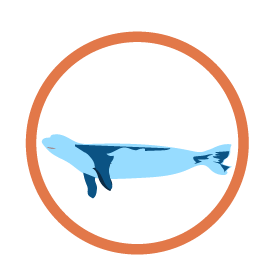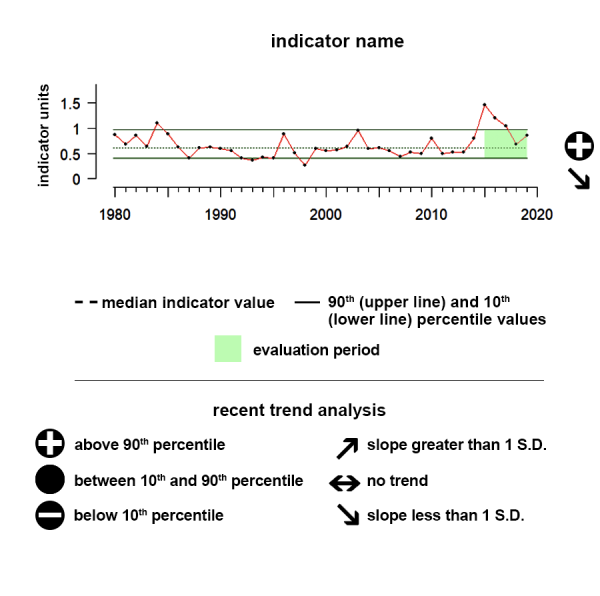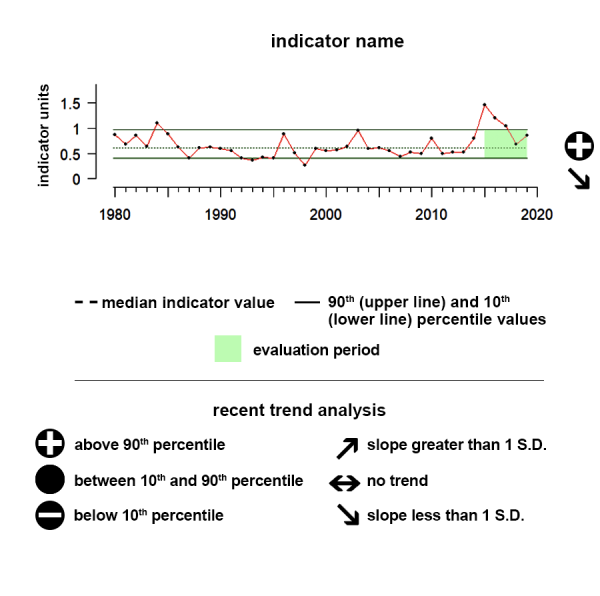
Description of Unusual Mortality Events:
Marine mammals are important parts of marine ecosystems. Sometimes we observe significant die-offs in a marine mammal population - also called unusual mortality events (UMEs). A UME is defined as "a stranding that is unexpected; involves a significant die-off of any marine mammal population; and demands immediate response." UMEs are often caused by ecological factors (e.g. changes in ocean conditions or food sources), biotoxins, infectious disease, and human interactions, but in some cases the cause cannot be determined. Some unusual mortality events occur over a period of months and others last for years. Understanding and investigating marine mammal UMEs is crucial because they can be indicators of ocean health, giving insight into larger environmental issues, which may also have implications for human health. We present the number of unusual marine mammal mortality events in a given year in all the Alaska, Pacific Islands, California Current, Gulf of Mexico, Southeast, and Northeast regions.
Data:
Unusual mortality event (UME) data for marine mammals were accessed from the NOAA Fisheries Active and Closed Unusual Mortality Events website (https://www.fisheries.noaa.gov/national/marine-life-distress/active-and-closed-unusual-mortality-events). A value of 1 was assigned for each UME (open and closed) reported as occurring for any portion of a given year and the values were summed by year for each region. For UMEs where the date range was not indicated, a value of 1 was applied only for the year the UME was declared.
Understanding the Time series plots
Time series plots show the changes in each indicator as a function of time, over the period 1980-present. Each plot also shows horizontal lines that indicate the median (middle) value of that indicator, as well as the 10th and 90th percentiles, each calculated for the entire period of measurement. Time series plots were only developed for datasets with at least 10 years of data. Two symbols located to the right of each plot describe how recent values of an indicator compare against the overall series. A black circle indicates whether the indicator values over the last five years are on average above the series 90th percentile (plus sign), below the 10th percentile (minus sign), or between those two values (solid circle). Beneath that an arrow reflects the trend of the indicator over the last five years; an increase or decrease greater than one standard deviation is reflected in upward or downward arrows respectively, while a change of less than one standard deviation is recorded by a left-right arrow.

Alaska

Description of time series:
Trend analysis is not appropriate for Marine Mammal Unusual Mortality Event data.
Description of Unusual Mortality events:
Marine mammals are important parts of marine ecosystems. Sometimes we observe significant die-offs in a marine mammal population - also called unusual mortality events (UMEs). A UME is defined as "a stranding that is unexpected; involves a significant die-off of any marine mammal population; and demands immediate response." UMEs are often caused by ecological factors (e.g. changes in ocean conditions or food sources), biotoxins, infectious disease, and human interactions, but in some cases the cause cannot be determined. Some unusual mortality events occur over a period of months and others last for years. Understanding and investigating marine mammal UMEs is crucial because they can be indicators of ocean health, giving insight into larger environmental issues, which may also have implications for human health. We present the number of unusual marine mammal mortality events in a given year in all the Alaska, Pacific Islands, California Current, Gulf of Mexico, Southeast, and Northeast regions.
Data:
Unusual mortality event (UME) data for marine mammals were accessed from the NOAA Fisheries Active and Closed Unusual Mortality Events website (https://www.fisheries.noaa.gov/national/marine-life-distress/active-and-closed-unusual-mortality-events). A value of 1 was assigned for each UME (open and closed) reported as occurring for any portion of a given year and the values were summed by year for each region. For UMEs where the date range was not indicated, a value of 1 was applied only for the year the UME was declared.
Hawaii-Pacific Islands

Description of time series:
Trend analysis is not appropriate for Marine Mammal Unusual Mortality Event data.
Description of Unusual Mortality events:
Marine mammals are important parts of marine ecosystems. Sometimes we observe significant die-offs in a marine mammal population - also called unusual mortality events (UMEs). A UME is defined as "a stranding that is unexpected; involves a significant die-off of any marine mammal population; and demands immediate response." UMEs are often caused by ecological factors (e.g. changes in ocean conditions or food sources), biotoxins, infectious disease, and human interactions, but in some cases the cause cannot be determined. Some unusual mortality events occur over a period of months and others last for years. Understanding and investigating marine mammal UMEs is crucial because they can be indicators of ocean health, giving insight into larger environmental issues, which may also have implications for human health. We present the number of unusual marine mammal mortality events in a given year in all the Alaska, Pacific Islands, California Current, Gulf of Mexico, Southeast, and Northeast regions.
Data:
Unusual mortality event (UME) data for marine mammals were accessed from the NOAA Fisheries Active and Closed Unusual Mortality Events website (https://www.fisheries.noaa.gov/national/marine-life-distress/active-and-closed-unusual-mortality-events). A value of 1 was assigned for each UME (open and closed) reported as occurring for any portion of a given year and the values were summed by year for each region. For UMEs where the date range was not indicated, a value of 1 was applied only for the year the UME was declared.
California Current

Description of time series:
Trend analysis is not appropriate for Marine Mammal Unusual Mortality Event data.
Description of Unusual Mortality events:
Marine mammals are important parts of marine ecosystems. Sometimes we observe significant die-offs in a marine mammal population - also called unusual mortality events (UMEs). A UME is defined as "a stranding that is unexpected; involves a significant die-off of any marine mammal population; and demands immediate response." UMEs are often caused by ecological factors (e.g. changes in ocean conditions or food sources), biotoxins, infectious disease, and human interactions, but in some cases the cause cannot be determined. Some unusual mortality events occur over a period of months and others last for years. Understanding and investigating marine mammal UMEs is crucial because they can be indicators of ocean health, giving insight into larger environmental issues, which may also have implications for human health. We present the number of unusual marine mammal mortality events in a given year in all the Alaska, Pacific Islands, California Current, Gulf of Mexico, Southeast, and Northeast regions.
Data:
Unusual mortality event (UME) data for marine mammals were accessed from the NOAA Fisheries Active and Closed Unusual Mortality Events website (https://www.fisheries.noaa.gov/national/marine-life-distress/active-and-closed-unusual-mortality-events). A value of 1 was assigned for each UME (open and closed) reported as occurring for any portion of a given year and the values were summed by year for each region. For UMEs where the date range was not indicated, a value of 1 was applied only for the year the UME was declared.
Gulf of Mexico

Description of time series:
Trend analysis is not appropriate for Marine Mammal Unusual Mortality Event data.
Description of Unusual Mortality events:
Marine mammals are important parts of marine ecosystems. Sometimes we observe significant die-offs in a marine mammal population - also called unusual mortality events (UMEs). A UME is defined as "a stranding that is unexpected; involves a significant die-off of any marine mammal population; and demands immediate response." UMEs are often caused by ecological factors (e.g. changes in ocean conditions or food sources), biotoxins, infectious disease, and human interactions, but in some cases the cause cannot be determined. Some unusual mortality events occur over a period of months and others last for years. Understanding and investigating marine mammal UMEs is crucial because they can be indicators of ocean health, giving insight into larger environmental issues, which may also have implications for human health. We present the number of unusual marine mammal mortality events in a given year in all the Alaska, Pacific Islands, California Current, Gulf of Mexico, Southeast, and Northeast regions.
Data:
Unusual mortality event (UME) data for marine mammals were accessed from the NOAA Fisheries Active and Closed Unusual Mortality Events website (https://www.fisheries.noaa.gov/national/marine-life-distress/active-and-closed-unusual-mortality-events). A value of 1 was assigned for each UME (open and closed) reported as occurring for any portion of a given year and the values were summed by year for each region. For UMEs where the date range was not indicated, a value of 1 was applied only for the year the UME was declared.
Southeast

Description of time series:
Trend analysis is not appropriate for Marine Mammal Unusual Mortality Event data.
Description of Unusual Mortality events:
Marine mammals are important parts of marine ecosystems. Sometimes we observe significant die-offs in a marine mammal population - also called unusual mortality events (UMEs). A UME is defined as "a stranding that is unexpected; involves a significant die-off of any marine mammal population; and demands immediate response." UMEs are often caused by ecological factors (e.g. changes in ocean conditions or food sources), biotoxins, infectious disease, and human interactions, but in some cases the cause cannot be determined. Some unusual mortality events occur over a period of months and others last for years. Understanding and investigating marine mammal UMEs is crucial because they can be indicators of ocean health, giving insight into larger environmental issues, which may also have implications for human health. We present the number of unusual marine mammal mortality events in a given year in all the Alaska, Pacific Islands, California Current, Gulf of Mexico, Southeast, and Northeast regions.
Data:
Unusual mortality event (UME) data for marine mammals were accessed from the NOAA Fisheries Active and Closed Unusual Mortality Events website (https://www.fisheries.noaa.gov/national/marine-life-distress/active-and-closed-unusual-mortality-events). A value of 1 was assigned for each UME (open and closed) reported as occurring for any portion of a given year and the values were summed by year for each region. For UMEs where the date range was not indicated, a value of 1 was applied only for the year the UME was declared.
Northeast

Description of time series:
Trend analysis is not appropriate for Marine Mammal Unusual Mortality Event data.
Description of Unusual Mortality events:
Marine mammals are important parts of marine ecosystems. Sometimes we observe significant die-offs in a marine mammal population - also called unusual mortality events (UMEs). A UME is defined as "a stranding that is unexpected; involves a significant die-off of any marine mammal population; and demands immediate response." UMEs are often caused by ecological factors (e.g. changes in ocean conditions or food sources), biotoxins, infectious disease, and human interactions, but in some cases the cause cannot be determined. Some unusual mortality events occur over a period of months and others last for years. Understanding and investigating marine mammal UMEs is crucial because they can be indicators of ocean health, giving insight into larger environmental issues, which may also have implications for human health. We present the number of unusual marine mammal mortality events in a given year in all the Alaska, Pacific Islands, California Current, Gulf of Mexico, Southeast, and Northeast regions.
Data:
Unusual mortality event (UME) data for marine mammals were accessed from the NOAA Fisheries Active and Closed Unusual Mortality Events website (https://www.fisheries.noaa.gov/national/marine-life-distress/active-and-closed-unusual-mortality-events). A value of 1 was assigned for each UME (open and closed) reported as occurring for any portion of a given year and the values were summed by year for each region. For UMEs where the date range was not indicated, a value of 1 was applied only for the year the UME was declared.
Resources
Active and Closed Unusual Mortality Events
Since 1991, marine mammal unusual mortality events (UMEs) have been declared.
